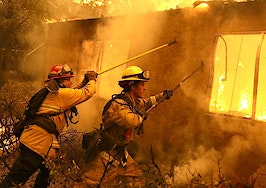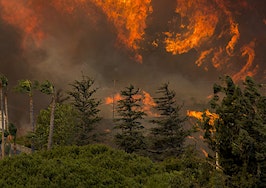In light of the recent fires that are devastating California, I am compelled to share an inspiring guide that my colleague, Ariel Palmieri, came up with after the fires hit Ventura last year. Hopefully the examples below will serve to establish a plan if you are going to take on this type of volunteer effort.
There are so many ways to help and everyone should do what is right for them. Here, agent Palmieri shares her story.
Giving back
In December 2017, the Thomas Fire raged through Western Ventura and Santa Barbara Counties. Schools were immediately closed, which meant kids had nothing but time on their hands.
Fire survivors, who lost their homes or whose homes were damaged beyond repair, found themselves temporarily homeless while they arranged for housing. Most evacuees left their homes after dark, with winds gusting as high as 80 MPH, and with no power.
The fire was speeding from one city to the next at rapid speeds, so once people learned they should evacuate, they had little time. This equated to people using flashlights or cell phones for lights, while rushing to get their children and their pets safely into their vehicles. Many could not open their garages with no power and winds making opening by hand very challenging.
Some grabbed important documents, some computers, many kids and teens grabbed their backpacks and school books! However, few packed enough clothing beyond what they were wearing and maybe some pajamas.
Fires do not discriminate
Survivors came from various socioeconomic backgrounds. While there were numerous large agencies offering group shelter and immediate-necessity items to those in need, many people could not fathom the idea of waiting for hours at the fairgrounds or sifting through generously donated items.
Many women left wearing their daughter’s shoes because they were all that could be found in the rush to evacuate. And while trying to arrange for new housing, helping their traumatized children, sifting through ashes and filing paperwork with insurance companies, the city and other agencies, clothing was the last thing on their minds.
In addition, the idea of shopping in regular stores was challenging. Although holiday music was playing and clerks were encouraged to be cheerful, it’s extremely hard when you are at an emotional low as a result of a disaster to find yourself shopping for clothing out of need, not because you are holiday gifting.
We quickly learned that large companies often host wonderful giving events after disasters, however, they often wait approximately six to eight weeks to do this for a variety of reasons, which include volunteer coordination, inventory delivery, securing a space large enough and publicizing the event to those in need.
Lives were changed
As a real estate professional, I knew that the livelihood of my colleagues was going to change dramatically as a result of the fire.
I knew that my colleagues who had lost their homes still needed business attire — as did professionals in other fields — and they still needed to work to keep the existing escrows and clients they had moving forward.
While they were focused on the loss of their homes, they also had to continue to serve their business needs so they could afford to move on.
I decided to utilize unoccupied rooms in my home to invite fire survivors to have a private, personal way to obtain some needed items.
I support several entrepreneurs who are consultants for home parties with clothing and jewelry. These companies often talk about how they give back during tragedies, and I thought perhaps we could call on them for immediate help.
I put the word out via direct texts, calls and also on Facebook that we were looking for new or perfect-condition items to offer to fire survivors. Women who sell upscale clothing, leggings and jewelry were more than happy to offer items from their samples, stock they were holding and personal belongings they had purchased but not yet worn.
A real estate colleague who owned a clothing boutique prior to becoming licensed still had inventory, and she donated all of it. A client who recently converted her clothing boutique to a home furnishings store still had inventory, which she donated.
We also had a client who worked in clothing manufacturing. We asked him to send items, and he agreed.
In addition, we informed our local real estate association of our plan. They distributed our need to our membership and offered to accept donations at the real estate association office. These were then delivered to the house where we hosted our boutique. Once we realized we would have clothing to offer, we needed ways to display it.
We asked for help on social media
We said we had needs for the following:
- Plastic hangers. White tubular hangers in all sizes were best.
- Clothing rolling racks. Many people have these in their garages for storing winter coats, for using during garage sales or for general organizing. Stores also have these for sidewalk sales. Once we put the word out, 12 racks were delivered within hours. (As you will be borrowing racks, ask that anyone offering their racks label them with his or her name and phone number. This will help when you are finished with this project.
- Large plastic bins. The best bins are 12-gallon clear totes with hinged lids.
Our colleague and client who owned stores also brought over a temporary dressing room and mirrors.
For those who wanted to donate, we advised the following
“We are collecting new items for donation to fire survivors. These can include NEW clothing or like-new sample clothing, shoes, hair care accessories (blow dryers, etc.), handbags, baby items, suitcases, electronics cases, cell phone chargers, and gift cards to any stores. Please refrain from donating used items. Many people have allergies to smoke, pets or perfumes, and those odors can linger on used clothing, handbags and shoes.
Items can be delivered to (insert address here). Items can also be ordered on Amazon and shipped to the same address. Gift cards are also appreciated. As we meet with families who have specific needs, we will post in case anyone would like to shop for families.”
Keep track of local volunteers
When other local people asked how they could help, we kept a list with their names. Then, when donors contacted us saying they had items to donate but could not deliver them, we asked those local volunteers to be our couriers.
We also put together a team of volunteers who offered to come to the house and help sort, display and serve as helpers to those who would eventually come to receive items. We had a children’s room and an adult room, and we arranged clothing as best we could by size, gender and style.
Our boutique ultimately offered new and like-new clothing and shoes for all ages, handbags, jewelry, new cosmetics, new hair care items and chargers for electronics.
We kept it private
Because we personally knew so many fire survivors, and those helping with our project did as well, we put the word out privately.
Since the boutique was in my home, we could not make it completely open to the public. We also wanted to ensure that fire survivors had privacy when coming to look for items. We asked that anyone in need contact me directly by text or cell, and I arranged private appointments for families.
We also had appointments for those who were helping their friends, family members or clients. Many came and did FaceTime calls with those they were helping to ensure they were only taking what would be of use.
How much could people take?
By offering each person who arrived a donated 12-gallon clear tote, it created a bit of an unofficial policy as to how much everyone should take.
We wanted people to feel comfortable taking a lot — not just one or two items. We also wanted there to be enough for everyone, but we didn’t want to enforce a limit. The totes worked extremely well because one can fit a lot of clothing and shoes inside, they don’t have lids that will get lost and they provide a place for people to store items until they are set up in housing again.
We also had a sign in notebook
Each family or individual who came was given an entire page in the notebook to protect privacy. We asked for their contact info — mailing address (most set up P.O. boxes), email, phone — and sizes.
We also asked them to note if they had any specific needs. Examples of this were: a Keurig machine, Blackberry charger (we found one!), pots and pans, counter microwave, luggage, toaster and very small shoes or very large shoes.
These were not donated in advance, but once we knew that people needed specific sizes, we could order them. When we heard that certain companies were giving away items or having giveaway days, we alerted those who had signed in.
Use social media
We also posted their needs on social media, had people who sent or dropped off the items that were requested, and then contacted the people who asked for them to come and pick them up.
After we closed our operation, we learned of others doing similar free boutiques. We continued to send notices of these events or private free shopping opportunities to those who signed in.
In doing this, there was a need to be firm about what should be donated and also the need for volunteers to help sort, display and be there when families came.
A plan for extra items
There was also the need to plan where the items would go if they were not appropriate for our purposes or if they remained after we were done with this assistance work.
In this case, we found two ideal places and people. First, in our county, there is a non-profit group that assists foster families. They have a store that is free for any foster families or people in the foster system to “shop” in.
We made contact with the director, who explained that even teenagers in their system might wear adult-size clothing and shoes and might come to the free store for clothing to wear to job interviews, college interviews or other more formal or business-oriented events, so she was willing to take clothing in all styles and sizes.
Second, there was a group of 20 farmworker families who lived on a ranch in Santa Paula and who lost their housing and their belongings. Our manager at Coldwell Banker Residential was personally working to help these families, and he was willing to take items to them.
With this in mind, when we received inventory that was not right for our purposes, as well as when we closed our operation, we arranged for these two sources to pick up what was remaining and use or distribute it accordingly.
‘Operation Scarlett’s Closet’
We named our operation “Scarlett’s Closet,” as my younger daughter, Scarlett, served as the assistant manager.
My older daughter, Avery, also participated. During the three weeks in the aftermath of the Thomas Fire that we had Scarlett’s Closet open, we worked with more than 50 families who lost their homes in the fire.
This was a wonderful opportunity to help when one would otherwise feel powerless, and it gave the kids something to do.
They served as organizers, greeters, and when families would come with children, they would ask if the kids could join them upstairs where they would make slime together or play.
We teamed up with more than a dozen volunteers to help run our boutique, and this allowed for a very organized way to approach it.
By spreading the word and offering up the experiences of a successful relief effort, I hope to give others the tools to remain hopeful, empowered, and best of all, able to show their support during their community’s greatest time of need.
If you plan to do something similar and would like any guidance, please feel free to contact Ariel Palmieri at ariel.palmieri@gmail.com or 805-746-2070.
Troy Palmquist is the founder and broker of The Address in Southern California. Follow him on Facebook, or connect with him on LinkedIn.













